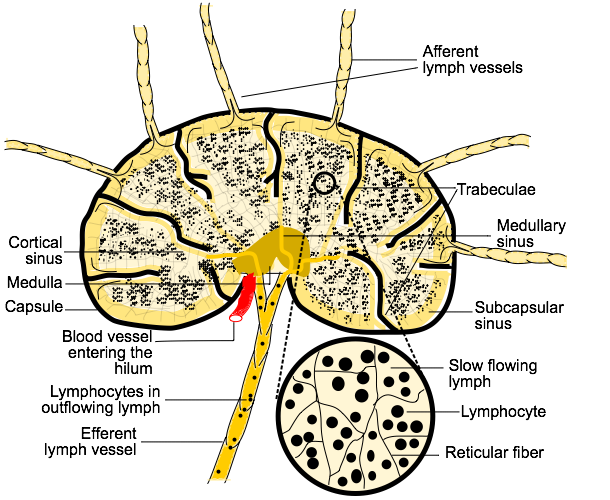19.2C: Lymph Transport
- Page ID
- 7907
Lymph circulates to the lymph node via afferent lymphatic vessels and drains into the lymph node in the subcapsular sinus.
- Describe the location of B cells and T cells in lymph nodes and the path of lymph circulation
Key Points
- The sinus space is crisscrossed by the pseudopods of macrophages, which act to trap foreign particles and filter the lymph.
- Lymph then leaves the lymph node via the efferent lymphatic vessel towards either a more central lymph node or for drainage into a central venous subclavian blood vessel.
- Lymphatic transport begins in the lymphatic capillaries, which converge into collecting vessels that flow into afferent vessels, then into lymph nodes.
- The lymph fluid leaves the node through efferent lymph vessels, which converge into lymphatic trunks, which in turn converge into one of the lymphatic ducts that flow lymph back into venous circulation.
- B and T lymphocytes must be transported to different sites within lymph nodes during an adaptive immune response.
Key Terms
- afferent lymphatic vessels: These vessels enter into the lymph nodes, flowing into the sinus space below the capsule of the node.
- lymph: A colorless, watery bodily fluid carried by the lymphatic system, consisting mainly of white blood cells.
- germinal centers: Places within secondary lymph nodes to which B cells migrate to proliferate and differentiate based on an antigen response.
Lymph transport refers to the transport of lymph fluid from the interstitial space inside the tissues of the body, through the lymph nodes, and into lymph ducts that return the fluid to venous circulation.
Transport in the Lymph Capillaries and Vessels
Lymphatic capillaries are the site of lymph fluid collection from the tissues. The fluid accumulates in the interstitial space inside tissues after leaking out through the cardiovascular capillaries. The fluid enters the lymphatic capillaries by leaking through the minivalves located in the junctions of the endothelium. Under ordinary conditions these minivalves prevent the lymph from flowing back into the tissues. In addition to interstitial fluid, pathogens, proteins, and tumor cells may also leak into the lymph capillaries and be transported through lymph.
The lymph capillaries feed into larger lymph vessels. The lymph vessels that receive lymph fluid from many capillaries are called collecting vessels. Semilunar valves work together with smooth muscle contractions and skeletal muscle pressure to slowly push the lymph fluid forward while the valves prevent backflow. The collecting vessels typically transport lymph fluid either into lymph nodes or lymph trunks.
Transport Within Lymph Nodes
Lymph circulates to the lymph node via afferent lymphatic vessels. The lymph fluid drains into the node just beneath the capsule of the node into its various sinus spaces. These spaces are loosely separated by walls, so lymph fluid flows around them throughout the lymph node.
The sinus space is filled with macrophages that engulf foreign particles and pathogens and filter the lymph. The sinuses converge at the hilum of the node, where lymph then leaves the node via an efferent lymphatic vessel toward either a more central lymph node or a lymph duct for drainage into one of the subclavian veins.
The lymph nodes contain a large number of B and T lymphocytes, which are transported throughout the node during many components of the adaptive immune response. When a lymphocyte is presented with an antigen (such as by an activated helper T cell), B cells become activated and migrate to the germinal centers of the node, where they proliferate and differentiate to be specific to that antigen. When antibody-producing B cells are formed, they migrate to the medullary (central) cords of the node. Stimulation of the lymphocytes by antigens can accelerate the migration process to about ten times normal, resulting in the characteristic swelling of the lymph nodes that is a common symptom of many infections. The lymphocytes are transported through lymph fluid and leave the node through the efferent vessels to travel to other parts of the body to perform adaptive immune response functions.

Flow of Lymph : The lymph flows from the afferent vessels into the sinuses of the lymph node, and then out of the node through the efferent vessels.
The End of Lymphatic Transport
After leaving the lymph node through efferent vessels, lymph travels either to another node further into the body or to a lymph trunk, the larger vessel where many efferent vessels converge. Four pairs of lymph trunks are distributed laterally around the center of the body, along with an unpaired intestinal trunk.
The lymph trunks then converge into the two lymph ducts, the right lymph duct and the thoracic duct. These ducts take the lymph into the right and left subclavian veins, which flow into the vena cava. This is where lymph fluid reaches the end of its journey from the interstitial space of tissues back into blood circulation.

